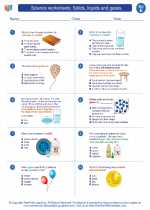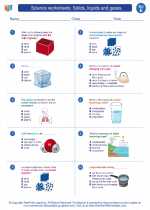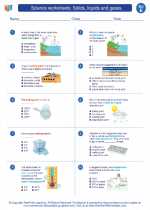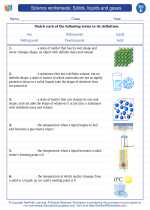Science worksheets: Solids, liquids and gases. -> evaporation
What is Evaporation?
Evaporation is the process in which a liquid changes into a gas at a temperature below its boiling point. It occurs when the molecules in a liquid gain enough energy to escape from the liquid's surface and become vapor.
Factors Affecting Evaporation
- Temperature: Higher temperatures generally lead to faster evaporation as the molecules in the liquid gain more energy.
- Surface Area: Increasing the surface area of the liquid can also speed up evaporation as more molecules are exposed to the air.
- Humidity: Lower humidity levels promote faster evaporation as the air can hold more water vapor.
- Wind: Wind can carry away water vapor from the liquid's surface, promoting faster evaporation.
Examples of Evaporation
Evaporation occurs naturally in everyday life. Some examples include:
- When a puddle of water dries up after a rainstorm.
- The evaporation of sweat from our skin helps us cool down on a hot day.
- The drying of wet clothes on a clothesline.
Importance of Evaporation
Evaporation is important for various reasons:
- It is a key part of the water cycle, where water evaporates from the Earth's surface and returns as precipitation.
- It is used in industrial processes such as the production of salt from seawater and the concentration of fruit juices.
- It helps regulate the Earth's temperature by transferring heat from the surface to the atmosphere.
Study Tips for Evaporation
When studying evaporation, it's important to:
- Understand the concept of evaporation and how it differs from boiling.
- Learn about the factors that affect the rate of evaporation and be able to provide examples of each factor in action.
- Be familiar with the importance of evaporation in the natural world and in human activities.
- Practice identifying examples of evaporation in everyday life.
◂Science Worksheets and Study Guides Fifth Grade. Science worksheets: Solids, liquids and gases.
Study Guide Solids, liquids and gases
Solids, liquids and gases  Worksheet/Answer key
Worksheet/Answer key Solids, liquids and gases
Solids, liquids and gases  Worksheet/Answer key
Worksheet/Answer key Solids, liquids and gases
Solids, liquids and gases  Worksheet/Answer key
Worksheet/Answer key Solids, liquids and gases
Solids, liquids and gases  Vocabulary/Answer key
Vocabulary/Answer key Solids, liquids and gases
Solids, liquids and gases 

 Worksheet/Answer key
Worksheet/Answer key
 Worksheet/Answer key
Worksheet/Answer key
 Worksheet/Answer key
Worksheet/Answer key
 Vocabulary/Answer key
Vocabulary/Answer key

The resources above cover the following skills:
PHYSICAL SCIENCE (NGSS)
Matter and Its Interactions
Students who demonstrate understanding can:
Make observations and measurements to identify materials based on their properties.